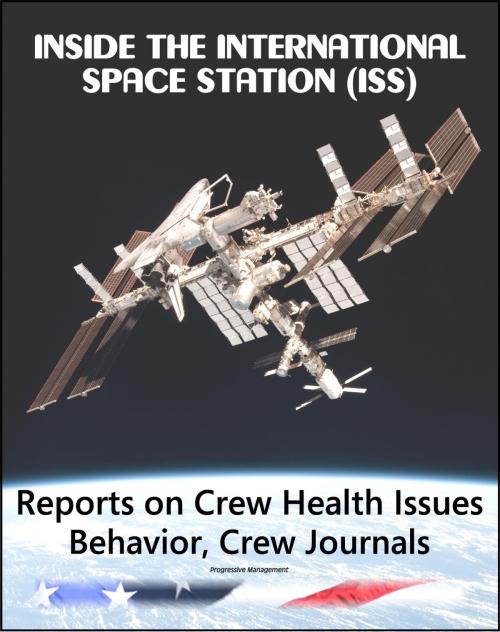Inside the International Space Station (ISS): Reports on Visual Impairment and Intracranial Pressure Problems, Behavioral Issues, Fascinating Excerpts from Crew Journals, Cross-Cultural Interactions
Nonfiction, Science & Nature, Technology, Aeronautics & Astronautics, Science, Physics, Astrophysics & Space Science| Author: | Progressive Management | ISBN: | 9781476188874 |
| Publisher: | Progressive Management | Publication: | May 12, 2012 |
| Imprint: | Smashwords Edition | Language: | English |
| Author: | Progressive Management |
| ISBN: | 9781476188874 |
| Publisher: | Progressive Management |
| Publication: | May 12, 2012 |
| Imprint: | Smashwords Edition |
| Language: | English |
Three official NASA documents - converted for accurate flowing-text ebook format reproduction - provide unique and illuminating information about life aboard the International Space Station for NASA astronauts:
The Visual Impairment Intracranial Pressure Summit Report - Space Life Sciences at Johnson Space Center held a Visual Impairment Intracranial Pressure (VIIP) Summit on Feb 8-10, 2011. The panel members stated that the vision, physiological, and anatomical changes observed in long-duration astronauts as documented in the seven cases presented are unlike any clinical entity they have seen as a collective. These changes, including elevated intracranial pressure, optic nerve sheath distention, globe flattening, and choroidal folds, do not appear to be severe enough to cause blindness near term; however, it is unknown if there could be long-term sequelae. The VIIP panel noted that NASA is doing an adequate job of monitoring and documenting changes in vision and the anatomy of the eye such as papilledema, choroidal folds, enlarged optic nerve sheath diameter optic nerve sheath diameter (ONSD), and axial length of the globe, etc. However, a higher resolution in-flight retinal imaging system that would allow early diagnosis of choroidal folds as well as mild retinal and optic nerve pathology is needed. Given the potentially serious nature of these changes, a method of early diagnosis could prove extremely valuable.
Behavioral Issues Associated with Long-Duration Space Expeditions: Review and Analysis of Astronaut Journals - This report describes a content analysis of personal journals that were maintained for this purpose by NASA astronauts during expeditions onboard the International Space Station (ISS). Using methods developed during previous analogue research, the study provides the first quantitative data on which to base a rank-ordering of the behavioral issues associated with long-duration space operations. The first level of analysis identified the relative salience of 24 major categories of issues with behavioral implications, among which the top 10 categories account for 88 percent of all journal entries: Work, Outside Communications, Adjustment, Group Interaction, Recreation/Leisure, Equipment, Events, Organization/Management, Sleep, and Food. Examples of journal entries and graphic representations of data are used to illustrate the quantitative analyses. Together, the entries and analyses provide a comprehensive description of ISS operations from the crew perspective. Example entries included in the report concern activities, events, and observations and reflect the normal ups and downs of daily life onboard an orbital space station. It is important to note that no single journal entry, nor even a subset of entries, accurately describes an entire expedition, but rather, the most salient issue at the time the entries were written. The results show that NASA's efforts concerning interpersonal issues, teamwork, psychological support, and leadership have been particularly effective. Operational implications of study results are summarized and then presented in the form of specific recommendations to facilitate living and working in space, whether onboard the ISS, a spacecraft bound for an asteroid, or an interplanetary ship.
Examination of Cross-Cultural Interactions aboard the International Space Station - Investigating the impact of culture within the astronaut population is a timely issue given that problems related to human interaction (including those that are culturally based) are likely to increase in prevalence as we move toward extreme long-duration space flight. In early space flight, the short duration of the missions caused psychological and interpersonal issues to be relatively inconsequential.
Three official NASA documents - converted for accurate flowing-text ebook format reproduction - provide unique and illuminating information about life aboard the International Space Station for NASA astronauts:
The Visual Impairment Intracranial Pressure Summit Report - Space Life Sciences at Johnson Space Center held a Visual Impairment Intracranial Pressure (VIIP) Summit on Feb 8-10, 2011. The panel members stated that the vision, physiological, and anatomical changes observed in long-duration astronauts as documented in the seven cases presented are unlike any clinical entity they have seen as a collective. These changes, including elevated intracranial pressure, optic nerve sheath distention, globe flattening, and choroidal folds, do not appear to be severe enough to cause blindness near term; however, it is unknown if there could be long-term sequelae. The VIIP panel noted that NASA is doing an adequate job of monitoring and documenting changes in vision and the anatomy of the eye such as papilledema, choroidal folds, enlarged optic nerve sheath diameter optic nerve sheath diameter (ONSD), and axial length of the globe, etc. However, a higher resolution in-flight retinal imaging system that would allow early diagnosis of choroidal folds as well as mild retinal and optic nerve pathology is needed. Given the potentially serious nature of these changes, a method of early diagnosis could prove extremely valuable.
Behavioral Issues Associated with Long-Duration Space Expeditions: Review and Analysis of Astronaut Journals - This report describes a content analysis of personal journals that were maintained for this purpose by NASA astronauts during expeditions onboard the International Space Station (ISS). Using methods developed during previous analogue research, the study provides the first quantitative data on which to base a rank-ordering of the behavioral issues associated with long-duration space operations. The first level of analysis identified the relative salience of 24 major categories of issues with behavioral implications, among which the top 10 categories account for 88 percent of all journal entries: Work, Outside Communications, Adjustment, Group Interaction, Recreation/Leisure, Equipment, Events, Organization/Management, Sleep, and Food. Examples of journal entries and graphic representations of data are used to illustrate the quantitative analyses. Together, the entries and analyses provide a comprehensive description of ISS operations from the crew perspective. Example entries included in the report concern activities, events, and observations and reflect the normal ups and downs of daily life onboard an orbital space station. It is important to note that no single journal entry, nor even a subset of entries, accurately describes an entire expedition, but rather, the most salient issue at the time the entries were written. The results show that NASA's efforts concerning interpersonal issues, teamwork, psychological support, and leadership have been particularly effective. Operational implications of study results are summarized and then presented in the form of specific recommendations to facilitate living and working in space, whether onboard the ISS, a spacecraft bound for an asteroid, or an interplanetary ship.
Examination of Cross-Cultural Interactions aboard the International Space Station - Investigating the impact of culture within the astronaut population is a timely issue given that problems related to human interaction (including those that are culturally based) are likely to increase in prevalence as we move toward extreme long-duration space flight. In early space flight, the short duration of the missions caused psychological and interpersonal issues to be relatively inconsequential.















